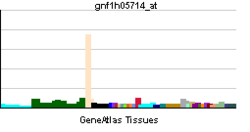JPH1
| Junctophilin 1 | |||||||||||||
|---|---|---|---|---|---|---|---|---|---|---|---|---|---|
| Identifiers | |||||||||||||
| Symbols | JPH1 ; JP-1; JP1 | ||||||||||||
| External IDs | OMIM: 605266 MGI: 1891495 HomoloGene: 10761 GeneCards: JPH1 Gene | ||||||||||||
| |||||||||||||
| RNA expression pattern | |||||||||||||
 | |||||||||||||
| More reference expression data | |||||||||||||
| Orthologs | |||||||||||||
| Species | Human | Mouse | |||||||||||
| Entrez | 56704 | 57339 | |||||||||||
| Ensembl | ENSG00000104369 | ENSMUSG00000042686 | |||||||||||
| UniProt | Q9HDC5 | Q9ET80 | |||||||||||
| RefSeq (mRNA) | NM_020647 | NM_020604 | |||||||||||
| RefSeq (protein) | NP_065698 | NP_065629 | |||||||||||
| Location (UCSC) | Chr 8: 75.15 – 75.23 Mb | Chr 1: 16.99 – 17.1 Mb | |||||||||||
| PubMed search | |||||||||||||
Junctophilin-1 is a protein that in humans is encoded by the JPH1 gene.[1][2][3]
Junctional complexes between the plasma membrane and endoplasmic/sarcoplasmic reticulum are a common feature of all excitable cell types and mediate cross talk between cell surface and intracellular ion channels. The protein encoded by this gene is a component of junctional complexes and is composed of a C-terminal hydrophobic segment spanning the endoplasmic/sarcoplasmic reticulum membrane and a remaining cytoplasmic domain that shows specific affinity for the plasma membrane. This gene is a member of the junctophilin gene family.[3]
References
- ↑ Nishi M, Mizushima A, Nakagawara K, Takeshima H (Sep 2000). "Characterization of human junctophilin subtype genes". Biochem Biophys Res Commun 273 (3): 920–7. doi:10.1006/bbrc.2000.3011. PMID 10891348.
- ↑ Takeshima H, Komazaki S, Nishi M, Iino M, Kangawa K (Aug 2000). "Junctophilins: a novel family of junctional membrane complex proteins". Mol Cell 6 (1): 11–22. doi:10.1016/S1097-2765(05)00005-5. PMID 10949023.
- ↑ 3.0 3.1 "Entrez Gene: JPH1 junctophilin 1".
Further reading
- Takeshima H (2003). "Ryanodine receptor and junctional membrane structure.". Nippon Yakurigaku Zasshi 121 (4): 203–10. doi:10.1254/fpj.121.203. PMID 12777839.
- Olsen JV, Blagoev B, Gnad F et al. (2006). "Global, in vivo, and site-specific phosphorylation dynamics in signaling networks.". Cell 127 (3): 635–48. doi:10.1016/j.cell.2006.09.026. PMID 17081983.
- Nusbaum C, Mikkelsen TS, Zody MC et al. (2006). "DNA sequence and analysis of human chromosome 8.". Nature 439 (7074): 331–5. doi:10.1038/nature04406. PMID 16421571.
- Brandenberger R, Wei H, Zhang S et al. (2005). "Transcriptome characterization elucidates signaling networks that control human ES cell growth and differentiation.". Nat. Biotechnol. 22 (6): 707–16. doi:10.1038/nbt971. PMID 15146197.
- Strausberg RL, Feingold EA, Grouse LH et al. (2003). "Generation and initial analysis of more than 15,000 full-length human and mouse cDNA sequences.". Proc. Natl. Acad. Sci. U.S.A. 99 (26): 16899–903. doi:10.1073/pnas.242603899. PMC 139241. PMID 12477932.
- Komazaki S, Ito K, Takeshima H, Nakamura H (2002). "Deficiency of triad formation in developing skeletal muscle cells lacking junctophilin type 1.". FEBS Lett. 524 (1-3): 225–9. doi:10.1016/S0014-5793(02)03042-9. PMID 12135771.